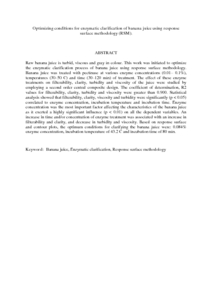Citation
Lee, W. C. and Yusof, Salmah and Sheikh Abdul Hamid, Nazimah and Baharin, Badlishah Sham
(2006)
Optimizing conditions for enzymatic clarification of banana
juice using response surface methodology (RSM).
Journal of Food Engineering, 73 (1).
pp. 55-63.
ISSN 0260-8774
Abstract
Raw banana juice is turbid, viscous and gray in colour. This work was initiated to optimize the enzymatic clarification process of
banana juice using response surface methodology. Banana juice was treated with pectinase at various enzyme concentrations (0.01–
0.1%), temperatures (30–50 C) and time (30–120 min) of treatment. The effect of these enzyme treatments on filterability, clarity,
turbidity and viscosity of the juice were studied by employing a second order central composite design. The coefficient of determination,
R2 values for filterability, clarity, turbidity and viscosity were greater than 0.900. Statistical analysis showed that filterability,
clarity, viscosity and turbidity were significantly (p < 0.05) correlated to enzyme concentration, incubation temperature and incubation
time. Enzyme concentration was the most important factor affecting the characteristics of the banana juice as it exerted a highly
significant influence (p < 0.01) on all the dependent variables. An increase in time and/or concentration of enzyme treatment was
associated with an increase in filterability and clarity, and decrease in turbidity and viscosity. Based on response surface and contour
plots, the optimum conditions for clarifying the banana juice were: 0.084% enzyme concentration, incubation temperature of 43.2 C
and incubation time of 80 min.
Download File
![[img]](http://psasir.upm.edu.my/6515/1.hassmallThumbnailVersion/Optimizing%20conditions%20for%20enzymatic%20clarification%20of%20banana%20juice%20using%20response%20surface%20methodology%20%28RSM%29..pdf)  Preview |
|
PDF (Abstract)
Optimizing conditions for enzymatic clarification of banana juice using response surface methodology (RSM)..pdf
Download (183kB)
| Preview
|
|
Additional Metadata
Actions (login required)
 |
View Item |

